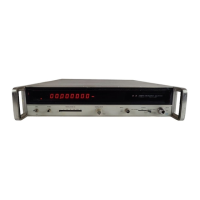TB 9-6625-2021-35
8
(4) Set function generator amplitude to 141 mVp-p. Adjust function generator
frequency from 10 Hz to 10 MHz. If TI does not display a stable indication of applied
frequency, perform b below.
(5) Disconnect function generator and 50Ω feedthrough termination from TI.
(6) Connect signal generator RF Output to TI INPUT 1 MΩΩ using a 50Ω
feedthrough termination.
(7) Set signal generator frequency to 10 MHz and level output to –50 dBm. Slowly
increase signal generator level output until TI displays a stable indication of applied frequency.
If signal generator level output exceeds –13 dBm, perform b below.
(8) Set signal generator level output to –13 dBm. Adjust signal generator
frequency from 10 to 250 MHz. If TI does not display a stable indication of applied
frequency, perform b below.
b. Adjustments
(1) Connect signal generator RF Output to TI INPUT 1 MΩΩ using a 50Ω
feedthrough termination.
(2) Set signal generator frequency to 100 MHz and level output to –13 dBm.
(3) Press RESOLUTION Hz pushbutton to 100 and adjust A3R10 (fig. 1) until a
stable count is displayed (R).
11. 10 Hz to 18 GHz Frequency and 50ΩΩ Input Sensitivity Check
a. Performance Check
CAUTION
Do not exceed 1 W of power to 50Ω input, otherwise extensive
damage will occur to the test instrument.
(1) Connect function generator Function Outputs Unbalanced to TI INPUT
50ΩΩ.
(2) Set RANGE switch to 10 Hz - 18 GHz and press RESOLUTION Hz
pushbutton to 10.
NOTE
Throughout the remainder of this check, press RESOLUTION
Hz pushbuttons as necessary.
(3) Set function generator for a sinewave, 10 Hz, 20 mVp-p, 50Ω output. If TI does
not display a stable indication of applied frequency, perform b below.
(4) Adjust function generator frequency from 10 Hz to 10 MHz. If TI does not
display a stable indication of applied frequency, perform b below.
(5) Disconnect function generator from TI.
(6) Connect signal generator RF Output to TI INPUT 50ΩΩ.

